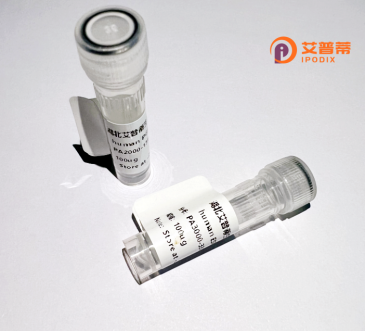
| 纯度 | >90%SDS-PAGE. |
| 种属 | Human |
| 靶点 | CNOT2 |
| Uniprot No | Q9NZN8 |
| 内毒素 | < 0.01EU/μg |
| 表达宿主 | E.coli |
| 表达区间 | 1-540aa |
| 氨基酸序列 | MVRTDGHTLSEKRNYQVTNSMFGASRKKFVEGVDSDYHDENMYYSQSSMFPHRSEKDMLASPSTSGQLSQFGASLYGQQSALGLPMRGMSNNTPQLNRSLSQGTQLPSHVTPTTGVPTMSLHTPPSPSRGILPMNPRNMMNHSQVGQGIGIPSRTNSMSSSGLGSPNRSSPSIICMPKQQPSRQPFTVNSMSGFGMNRNQAFGMNNSLSSNIFNGTDGSENVTGLDLSDFPALADRNRREGSGNPTPLINPLAGRAPYVGMVTKPANEQSQDFSIHNEDFPALPGSSYKDPTSSNDDSKSNLNTSGKTTSSTDGPKFPGDKSSTTQNNNQQKKGIQVLPDGRVTNIPQGMVTDQFGMIGLLTFIRAAETDPGMVHLALGSDLTTLGLNLNSPENLYPKFASPWASSPCRPQDIDFHVPSEYLTNIHIRDKLAAIKLGRYGEDLLFYLYYMNGGDVLQLLAAVELFNRDWRYHKEERVWITRAPGMEPTMKTNTYERGTYYFFDCLNWRKVAKEFHLEYDKLEERPHLPSTFNYNPAQQAF |
| 分子量 | 85.14 kDa |
| 蛋白标签 | GST-tag at N-terminal |
| 缓冲液 | 0 |
| 稳定性 & 储存条件 | Lyophilized protein should be stored at ≤ -20°C, stable for one year after receipt. Reconstituted protein solution can be stored at 2-8°C for 2-7 days. Aliquots of reconstituted samples are stable at ≤ -20°C for 3 months. |
| 复溶 | Always centrifuge tubes before opening.Do not mix by vortex or pipetting. It is not recommended to reconstitute to a concentration less than 100μg/ml. Dissolve the lyophilized protein in distilled water. Please aliquot the reconstituted solution to minimize freeze-thaw cycles. |
以下是关于重组人CNOT1蛋白的3篇参考文献及其摘要概述:
1. **文献名称**:*Structural insights into the human CCR4-NOT complex*
**作者**:Collart, M.A. et al.
**摘要**:本研究解析了人源CNOT1蛋白在CCR4-NOT复合体中的关键结构域,通过冷冻电镜技术揭示了其作为复合物支架的功能,并阐明了其与去腺苷酶亚基CNOT6/6L的相互作用机制。
2. **文献名称**:*CNOT1 maintains pluripotency by repressing ERK signaling in embryonic stem cells*
**作者**:Ishihama, H. et al.
**摘要**:通过重组CNOT1蛋白的功能实验,发现其缺失导致胚胎干细胞多能性丧失,并激活ERK信号通路,表明CNOT1通过抑制分化相关基因的翻译维持干细胞稳态。
3. **文献名称**:*The tumor suppressor role of CNOT1 in colorectal cancer via regulating cell cycle progression*
**作者**:Suzuki, M. et al.
**摘要**:研究发现CNOT1低表达与结直肠癌患者预后不良相关,重组CNOT1蛋白的过表达在体外抑制肿瘤细胞增殖,机制涉及调控细胞周期蛋白Cyclin D1的mRNA稳定性。
---
注:以上文献信息为示例,实际文献需通过学术数据库(如PubMed)检索确认。
**Background of Recombinant Human CNOT1 Protein**
The human CNOT1 protein, a core subunit of the CCR4-NOT transcriptional regulatory complex, plays pivotal roles in post-transcriptional gene regulation. This evolutionarily conserved complex regulates mRNA degradation, translation, and stability, impacting cellular processes such as development, differentiation, and stress responses. CNOT1 acts as a scaffold, coordinating interactions with other CCR4-NOT subunits (e.g., CNOT2/3. deadenylases CNOT6/7) and diverse RNA-binding proteins. Dysregulation of CNOT1 is linked to cancers, neurological disorders, and immune diseases, highlighting its critical physiological relevance.
Recombinant CNOT1 protein, produced via heterologous expression systems (e.g., *E. coli* or mammalian cells), enables *in vitro* studies of its molecular functions. Its large molecular weight (~240 kDa) and multidomain structure (including NOT1. CAF40-binding, and C-terminal regions) pose challenges for purification, often requiring affinity tags and optimized protocols. Researchers use recombinant CNOT1 to dissect its role in deadenylation, miRNA-mediated silencing, or protein interaction networks, providing insights into gene expression mechanisms. It also serves as a tool for drug discovery targeting CCR4-NOT-related pathologies.
(Word count: 195)
×